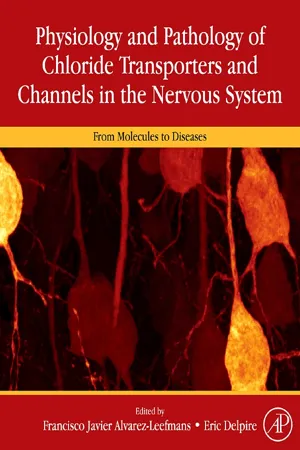
Physiology and Pathology of Chloride Transporters and Channels in the Nervous System
From Molecules to Diseases
F. Javier Alvarez-Leefmans,Eric Delpire
- 630 Seiten
- English
- ePUB (handyfreundlich)
- Über iOS und Android verfügbar
Physiology and Pathology of Chloride Transporters and Channels in the Nervous System
From Molecules to Diseases
F. Javier Alvarez-Leefmans,Eric Delpire
Über dieses Buch
The importance of chloride ions in cell physiology has not been fully recognized until recently, in spite of the fact that chloride (Cl-), together with bicarbonate, is the most abundant free anion in animal cells, and performs or determines fundamental biological functions in all tissues. For many years it was thought that Cl- was distributed in thermodynamic equilibrium across the plasma membrane of most cells. Research carried out during the last couple of decades has led to a dramatic change in this simplistic view. We now know that most animal cells, neurons included, exhibit a non-equilibrium distribution of Cl- across their plasma membranes. Over the last 10 to 15 years, with the growth of molecular biology and the advent of new optical methods, an enormous amount of exciting new information has become available on the molecular structure and function of Cl- channels and carriers. In nerve cells, Cl- channels and carriers play key functional roles in GABA- and glycine-mediated synaptic inhibition, neuronal growth and development, extracellular potassium scavenging, sensory-transduction, neurotransmitter uptake and cell volume control. Disruption of Cl- homeostasis in neurons underlies pathological conditions such as epilepsy, deafness, imbalance, brain edema and ischemia, pain and neurogenic inflammation. This book is about how chloride ions are regulated and how they cross the plasma membrane of neurons. It spans from molecular structure and function of carriers and channels involved in Cl- transport to their role in various diseases.
- The first comprehensive book on the structure, molecular biology, cell physiology, and role in diseases of chloride transporters / channels in the nervous system in almost 20 years
- Chloride is the most abundant free anion in animal cells. THis book summarizes and integrates for the first time the important research of the past two decades that has shown that Cl- channels and carriers play key functional roles in GABA- and glycine-mediated synaptic inhibition, neuronal growth and development, extracellular potassium scavenging, sensory-transduction, neurotransmitter uptake and cell volume control
- The first book that systematically discusses the result of disruption of Cl- homeostasis in neurons which underlies pathological conditions such as epilepsy, deafness, imbalance, brain edema and ischemia, pain and neurogenic inflammation
- Spanning topics from molecular structure and function of carriers and channels involved in Cl- transport to their role in various diseases
- Involves all of the leading researchers in the field
- Includes an extensive introductory section that covers basic thermodynamic and kinetics aspects of Cl- transport, as well as current methods for studying Cl- regulation, spanning from fluorescent dyes in single cells to knock-out models to make the book available for a growing population of graduate students and postdocs entering the field
Häufig gestellte Fragen
Information
Inhaltsverzeichnis
- Cover Image
- Table of Contents
- Copyright
- Preface
- List of Contributors
- Chapter 1. Chloride Channels
- Chapter 2. Sodium-Coupled Chloride Cotransporters
- Chapter 3. Pathophysiology of the K+-Cl− Cotransporters
- Chapter 4. From Cloning to Structure, Function, and Regulation of Chloride-dependent and Independent Bicarbonate Transporters
- I. Introduction
- II. History of Anion Exchangers
- III. Modes of Membrane Anion Transport – Theoretical
- IV. The Focus of the Review
- V. SLC4 Anion Exchangers and Cotransporters
- VI. SLC26 Anion Exchangers/Transporters/Channels
- Chapter 5. Thermodynamics and Kinetics of Chloride Transport in Neurons
- Chapter 6. Chemical and GFP-Based Fluorescent Chloride Indicators
- Chapter 7. Clomeleon, a Genetically Encoded Chloride Indicator
- Chapter 8. Gramicidin Perforated Patch
- Chapter 9. Measuring Electroneutral Chloride-Dependent Ion Fluxes in Mammalian Cells and in Heterologous Expression Systems
- Chapter 10. Knockout Models of Cation-Chloride Cotransporters
- Chapter 11. The NKCC and NCC Genes
- Chapter 12. The CLC Family of Chloride Channels and Transporters
- Chapter 13. Calcium-Activated Chloride Channels
- Chapter 14. GABAA Receptor Channels
- Chapter 15. The Puzzles of Volume-Activated Anion Channels
- Chapter 16. The Sodium-Dependent Chloride Cotransporters
- Chapter 17. The Potassium-Chloride Cotransporters
- Chapter 18. Regulation of Cation-Chloride Cotransporters
- Chapter 19. GABA, Glycine and Cation-Chloride Cotransporters in Retinal Function and Development
- Chapter 20. Chloride-Based Signal Amplification in Olfactory Sensory Neurons
- Chapter 21. Cochlear and Vestibular Function and Dysfunction
- Chapter 22. Chloride Transporters in Presynaptic Inhibition, Pain and Neurogenic Inflammation
- Chapter 23. Modulation of Chloride Homeostasis by Microglia
- Chapter 24. Cation-Chloride Cotransporters as Pharmacological Targets in the Treatment of Epilepsy
- Chapter 25. The Role of Cation-Chloride Transporters in Brain Ischemia
- Chapter 26. Chloride Transport in Glioma Growth and Cell Invasion
- Chapter 27. The Sodium-Potassium-Chloride Cotransporter, Human Cytomegalovirus and the Cell Cycle
- Chapter 28. Chloride Transporters as Water Pumps
- Chapter 29. Ion Transport in Choroid Plexus
- Chapter 30. Ion and Water Transport across the Blood–Brain Barrier
- Index